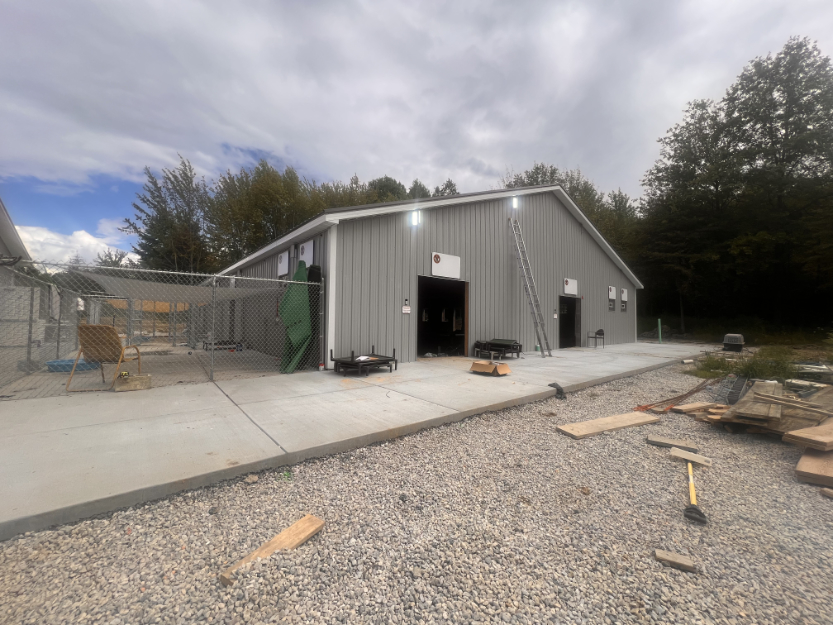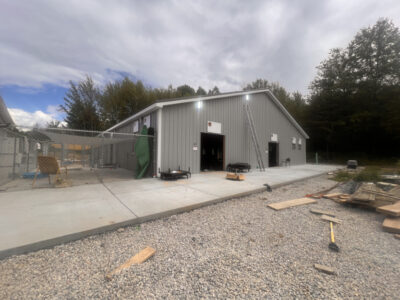New dog shelter building taking shape

Staff photo / Chris McBride This is a view of a 4,200-square-foot building that Healthy Hearts and Paws President and CEO Jason Cooke said will house up to 35 dogs, relieving their main building that he says is operating at over capacity.
WARREN — A new 4,200-square-foot building is taking shape on Martin Luther King Boulevard, which set to become a new home for dozens of dogs.
The structure is the latest expansion for Healthy Hearts and Paws, a local animal shelter trying to increase its capacity amid a surge of animals being taken into their facility.
The $600,000 facility, funded through donations and fundraising, will add 35 additional spots for dogs, complete with indoor and outdoor play areas and a dedicated space for smaller breeds. However, shelter president and CEO Jason Cooke said the expansion won’t fully resolve the ongoing issue of animal overflow.
The new building is expected to include indoor play areas to help dogs “destress.”
The shelter recently opened Bootsie’s Bungalow, a $50,000 cat-specific facility housing 11 cats, funded by donations and private foundations. This allowed the former cat room to be repurposed as a dog play area. Additionally, a pet food pantry supports struggling families to prevent pet surrenders.
“We need more space. We have 85 dogs right now,” Cooke said, noting that the shelter housed 57 dogs when it opened at its new location in March. Despite the addition of the new building, which broke ground in December, Cooke said that the influx of abandoned and stray dogs continues to strain capacity.
The shelter’s challenges are compounded by a troubling trend in the surrounding area. Within a half-mile radius of the shelter, Cooke said multiple dogs have been found abandoned in distressing conditions. Two pit bull terriers were discovered inside a garbage bag in an old boat at the corner of Choctaw and Pershing avenues. Another dog, wrapped in a blanket, was found deceased on Peerless Avenue SW. On Front Street, two deceased dogs were left in crates alongside a surviving third, and two additional dogs were abandoned nearby but survived.
“We’re seeing dogs that are otherwise healthy, finding them in garbage bags, blankets, and various stages of decay,” Cooke said. “They didn’t put themselves in a bag. They didn’t wrap themselves up in a blanket. They didn’t leave themselves in crates.”
Cooke suspects the area is becoming a “dumping ground” for unwanted animals. “It’s hard to determine exactly what’s happening, but there’s something going on,” he said.
The proximity of these incidents to the shelter, less than a quarter-mile away, raises questions, Cooke said.
To address the issue, Cooke has suggested cameras from the city to deter illegal dumping and suggested signage to discourage abandoning animals.
“It’s a shame you have to put up a sign that says you can’t dump your animals,” he said, acknowledging that such measures might only push the problem to another location in Warren, where desolate areas provide opportunity for abandonment.
Cooke remains frustrated by the reluctance to bring animals directly to the shelter. “Why not just drive the quarter of a mile up the road to the shelter? They know we’re here,” he said.
The shelter, staffed by 60 dedicated volunteers, continues to advocate for responsible pet ownership, emphasizing spaying, neutering and vaccinations to curb animal overpopulation. As construction progresses, Cooke hopes the new building will alleviate some pressure, but the persistent abandonment problem underscores the need for broader community solutions.
“We’re convinced there are probably more dogs out there being dumped like this, and we just don’t know about it,” Cooke said.

